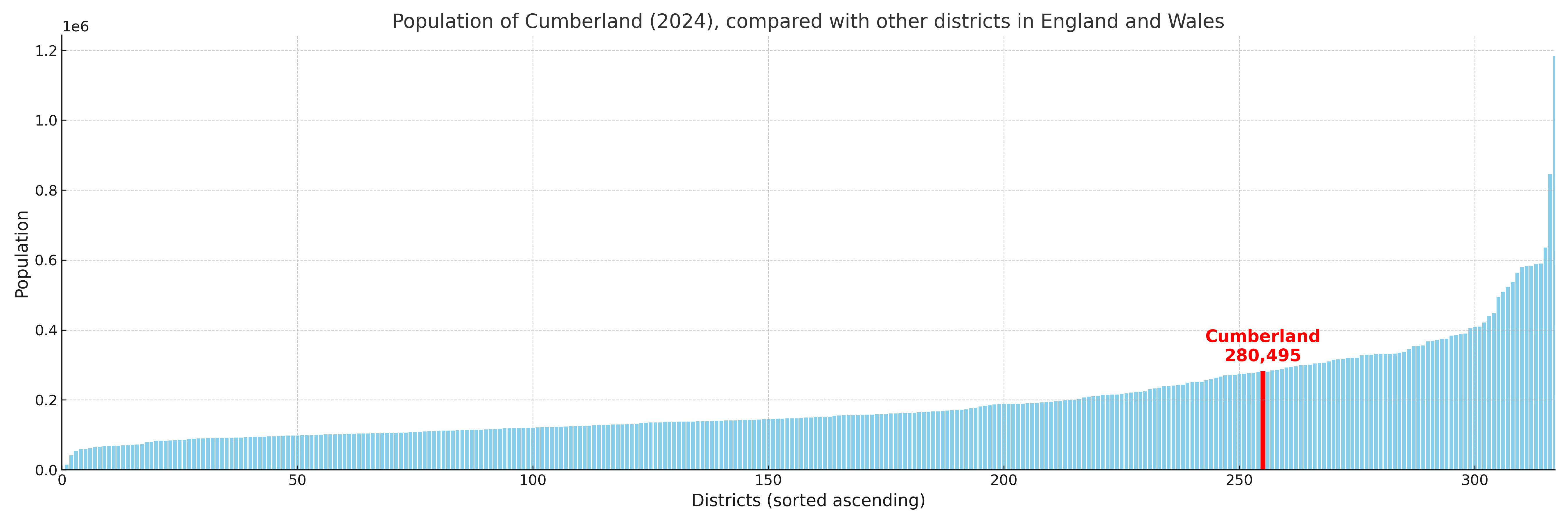Cumberland
§ This page gives an overview of the Cumberland local authority district, bringing together key facts, maps, and data to help you quickly understand the area. One of 361 district profiles on Baseview.
Overview ⁞ Cumberland covers the western part of Cumbria, stretching from the Lake District mountains to the Irish Sea coast. Carlisle is the main city, with its medieval castle, cathedral, and proximity to Hadrian’s Wall. The Lake District National Park extends into the district, including mountains like Skiddaw, lakes such as Bassenthwaite and Derwentwater, and towns like Keswick, a hub for walking and outdoor pursuits. The Solway Firth and coastal towns such as Workington, Whitehaven, and Maryport provide maritime character, while inland valleys and fells highlight dramatic scenery. Cumberland’s geography blends coast, mountains, rivers, and historic settlements in one of England’s most diverse landscapes.
Cumberland Boundary Map
This map shows the official boundary of the Cumberland local authority district, based on the latest geographic data published by the Office for National Statistics (ONS). It provides a clear view of the district’s extent and helps you understand how the area fits within the wider regional and national landscape.
Contains OS data © Crown copyright and database right 2025. Source: Office for National Statistics licensed under the Open Government Licence v3.0.
The administrative boundary of Cumberland can also be viewed on OpenStreetMap: District Boundary of Cumberland.
Key Facts about Cumberland
What region is Cumberland in? Cumberland is in the North West of England, a region within the UK.
What county is Cumberland in? Cumberland is in the county of Cumbria.
Is Cumberland a city? Yes, Cumberland is a city. Cumberland holds official city status as one of the 76 designated cities in the UK.
Who governs Cumberland? The local government for this district is: Cumberland Council (Unitary Authority).
▶ Official website of Cumberland Council 🔗 cumberland.gov.uk

Which police force covers Cumberland? Policing in Cumberland is provided by Cumbria Constabulary 🔗 cumbria.police.uk, which serves 2 local authority districts: Cumberland ⁞ Westmorland and Furness.
Cumberland in International Geographies
In the International Territorial Levels (ITLs) hierarchy, Cumberland is an ITLs Level 3 area:
- (ITL 1) North West
- (ITL 2) ⇒ Cumbria
- (ITL 3) ⇒⇒ Cumberland
The International Territorial Levels are used by OECD member countries for statistical purposes to classify administrative areas. We have this listable page for easy browsing of ITL names and codes: International Territorial Levels.
Constituencies in Cumberland
Cumberland is divided into 4 parliamentary constituencies, listed below in alphabetical order.
A constituency is a specific geographical area that elects one Member of Parliament (MP) to represent them in the House of Commons. The United Kingdom is divided into 650 parliamentary constituencies. We have this list page for easy browsing of all UK parliamentary constituencies: List of Constituencies.
Wards in Cumberland
Cumberland is divided into 46 wards, listed below in alphabetical order.
- Aspatria
- Belah
- Belle Vue
- Botcherby
- Bothel and Wharrels
- Brampton
- Bransty
- Castle
- Cleator Moor East and Frizington
- Cleator Moor West
- Cockermouth North
- Cockermouth South
- Corby and Hayton
- Currock
- Dalston and Burgh
- Dearham and Broughton
- Denton Holme
- Egremont
- Egremont North and St Bees
- Gosforth
- Harraby North
- Harraby South
- Harrington
- Hillcrest and Hensingham
- Houghton and Irthington
- Howgate
- Kells and Sandwith
- Keswick
- Longtown
- Maryport North
- Maryport South
- Millom
- Millom Without
- Mirehouse
- Morton
- Moss Bay and Moorclose
- Seaton
- Solway Coast
- St John's and Great Clifton
- St Michael's
- Stanwix Urban
- Thursby
- Upperby
- Wetheral
- Wigton
- Yewdale
In the UK, a ward is a subdivision of a local authority area, used mainly for electoral and statistical purposes. Defined by the ONS, wards represent the primary unit for local elections, each returning one or more councillors to the local council. Wards are also used as a key geography for presenting population and census data.
Parishes in Cumberland
Cumberland is part-parished: 128 civil parishes (listed A-Z below) alongside 1 unparished areas.
- Above Derwent
- Aikton
- Allhallows
- Allonby
- Arlecdon and Frizington
- Arthuret
- Askerton
- Aspatria
- Bassenthwaite
- Beaumont
- Beckermet
- Bewaldeth and Snittlegarth
- Bewcastle
- Blennerhasset and Torpenhow
- Blindbothel
- Blindcrake
- Boltons
- Bootle
- Borrowdale
- Bothel and Threapland
- Bowness
- Brampton
- Bridekirk
- Brigham
- Bromfield
- Broughton
- Broughton Moor
- Burgh by Sands
- Burtholme
- Buttermere
- Caldbeck
- Camerton
- Carlatton
- Castle Carrock
- Cleator Moor
- Cockermouth
- Crosscanonby
- Cummersdale
- Cumrew
- Cumwhitton
- Dalston
- Dean
- Dearham
- Distington
- Drigg and Carleton
- Dundraw
- Egremont
- Embleton
- Ennerdale and Kinniside
- Eskdale
- Farlam
- Gilcrux
- Gosforth
- Great Clifton
- Greysouthen
- Haile
- Hayton
- Hayton and Mealo
- Hethersgill
- Holme Abbey
- Holme East Waver
- Holme Low
- Holme St Cuthbert
- Ireby and Uldale
- Irthington
- Irton with Santon
- Keswick
- Kingmoor
- Kingwater
- Kirkandrews
- Kirkbampton
- Kirkbride
- Kirklinton Middle
- Lamplugh
- Lands common to Holme Abbey, Holme Low and Holme St Cuthbert
- Little Clifton
- Lorton
- Lowca
- Loweswater
- Lowside Quarter
- Maryport
- Midgeholme
- Millom
- Millom Without
- Moresby
- Muncaster
- Nether Denton
- Nicholforest
- Orton
- Oughterside and Allerby
- Papcastle
- Parton
- Plumbland
- Ponsonby
- Rockcliffe
- Scaleby
- Seascale
- Seaton
- Sebergham
- Setmurthy
- Silloth-on-Solway
- Solport
- St Cuthbert Without
- St John's Castlerigg and Wythburn
- St. Bees
- Stanwix Rural
- Stapleton
- Thursby
- Ulpha
- Underskiddaw
- Upper Denton
- Waberthwaite
- Walton
- Wasdale
- Waterhead
- Waverton
- Weddicar
- Westlinton
- Westnewton
- Westward
- Wetheral
- Whicham
- Whitehaven
- Wigton
- Winscales
- Woodside
- Workington
- Wythop
A civil parish is the lowest tier of local government in England, used for villages, small towns, and suburbs. They have their own local authority, either a parish council or a parish meeting, which provides local services like managing parks, allotments, and streetlights, and represents the community's views to larger councils.
Built-up Areas in Cumberland
Cumberland covers 72 built-up areas, listed below in alphabetical order.
- Abbeytown
- Allonby
- Arlecdon
- Aspatria
- Beckermet
- Bigrigg
- Blackbank
- Blackwell (Carlisle)
- Bootle (Copeland)
- Bothel
- Braithwaite
- Brampton (Carlisle)
- Brigham
- Broughton Moor
- Burgh by Sands
- Caldbeck
- Cargo
- Carlisle
- Cleator Moor
- Cockermouth
- Crosby (Allerdale)
- Cumwhinton
- Dalston
- Dearham
- Distington
- Dovenby
- Egremont
- Flimby
- Frizington
- Gilsland *
- Gosforth
- Great Broughton and Little Broughton
- Great Clifton
- Greysouthen
- Harker
- Haverigg
- Hayton (Carlisle)
- Heads Nook
- High Harrington
- Houghton (Carlisle)
- Howbeck
- Keswick
- Kirkbride
- Longtown
- Lowca
- Maryport
- Millom
- Moor Row
- Moresby Parks
- Oldwall
- Parton
- Portinscale
- Redmain
- Rheda Park
- Scotby
- Seascale
- Seaton (Allerdale)
- Sellafield
- Siddick
- Silloth
- Skinburness
- St Bees
- Stainburn
- Tallentire
- Thornhill (Copeland)
- Thursby
- Warwick Bridge
- Wetheral
- Whitehaven
- Wigton
- Winscales
- Workington
In the UK, a Built-up Area (BUA) is a continuous urban area of at least 20 hectares (0.2 km²), defined by the ONS as land where buildings are generally no more than 200 metres apart, such as towns, cities, or large villages. (Note: A BUA name marked with an asterisk (*) indicates that the area is situated partly in the district of Cumberland.)
Cumberland compared with other districts in the UK
This section shows how Cumberland compares with other local authority districts in the UK, using a variety of measures and rankings.
Cumberland has 46 electoral wards.

Cumberland has a population of 280,495 (2024 mid-year estimate by ONS)

More local statistics and data for Cumberland can be found on the ONS statistics for Cumberland.